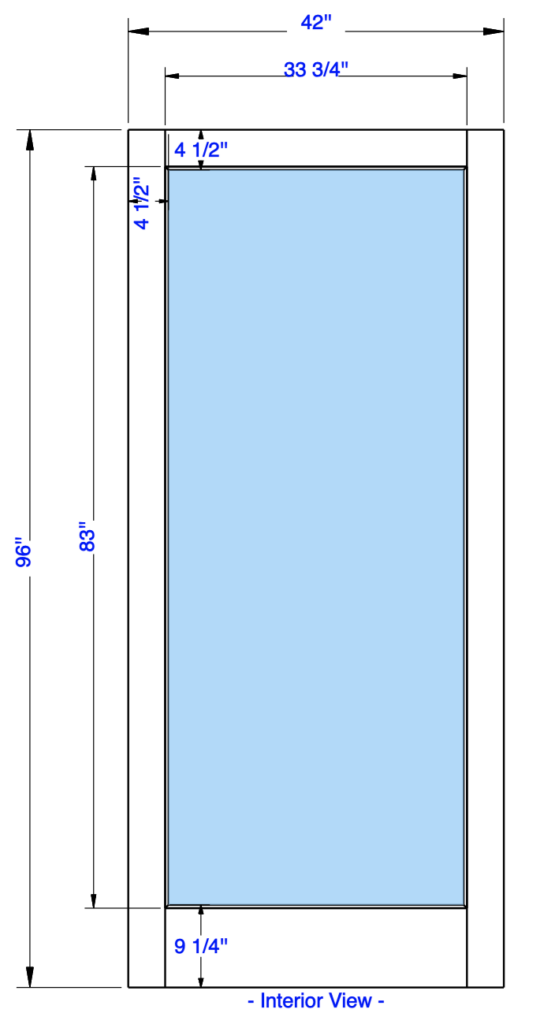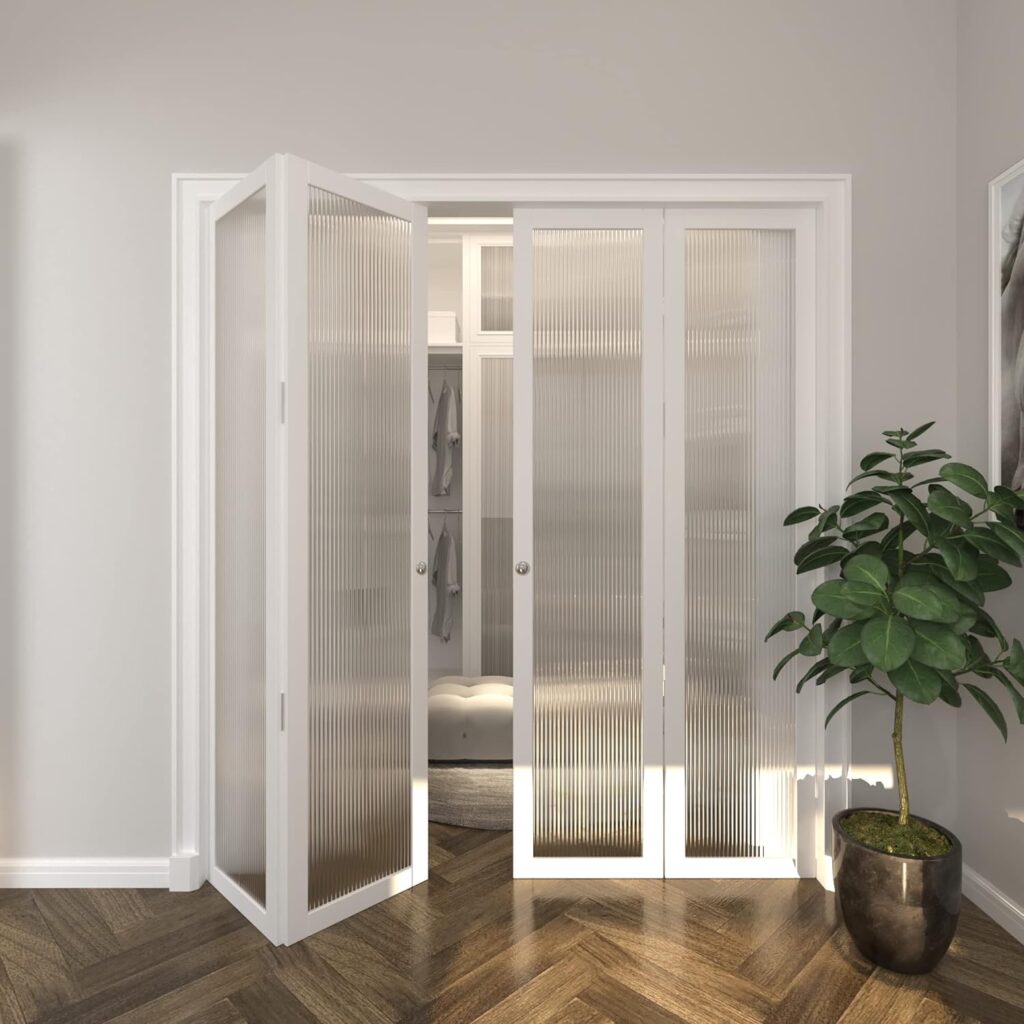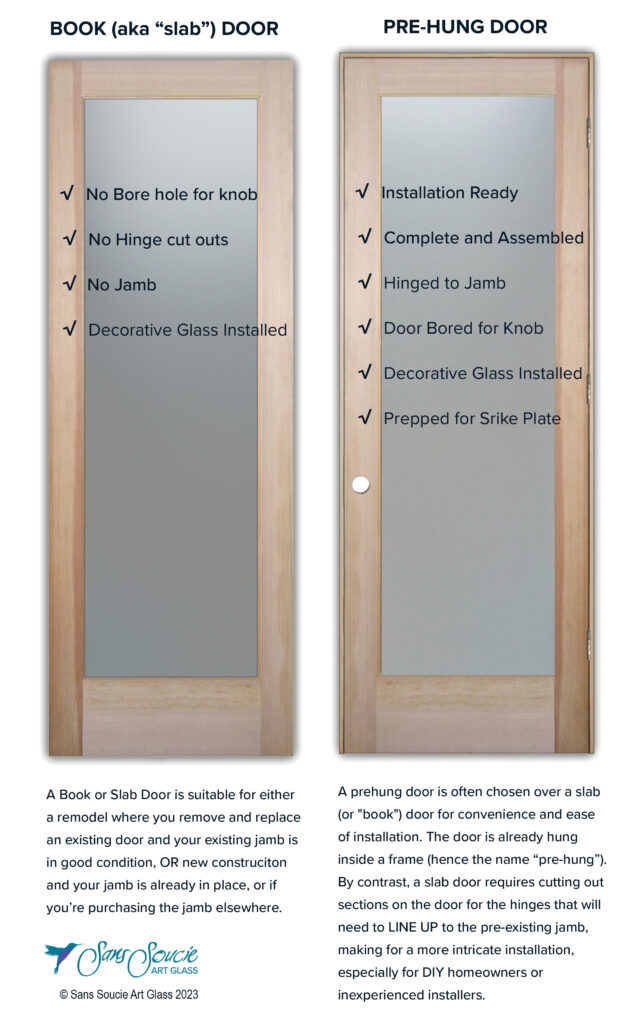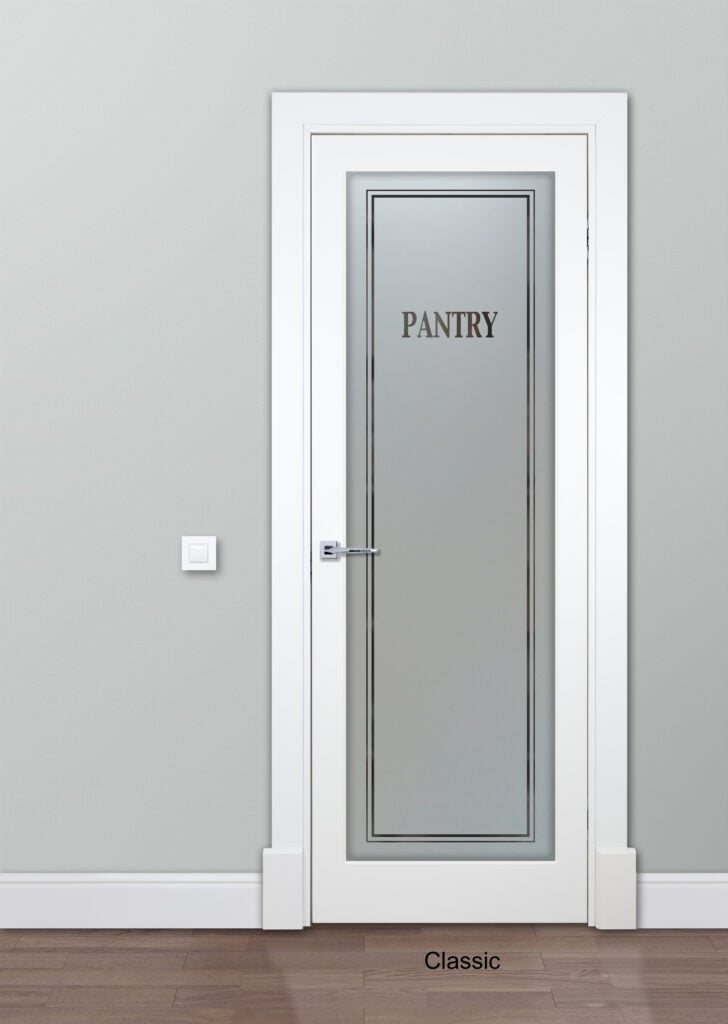What Are the Standard Pantry Door Sizes?
Standard pantry door sizes fluctuate between 24” to 36” in width and 80” to 96” in height, which can accommodate a range of pantry dimensions. With an array of standard pantry door sizes, types, materials, and customization options, you can create a pantry door that perfectly complements your kitchen’s design. At Sans Soucie Art Glass, we’re we’re all about making things visual and fun. In this article, we’ve thrown in some snazzy visual aids to help you see the size and scale of your pantry, based on its size. Ready to take a visual journey? Let’s dive in and explore the world of pantry doors and discover how to choose the best fit for your space.
Key Takeaways
- Standard pantry door sizes range from 24” to 36” in width and 80”-96” in height.
- Consider factors such as space, type of pantry and user preference when selecting a size.
- Various materials and styles are available for customization. Proper measurement & installation is essential for successful fit.
Standard Pantry Door Sizes
As mentioned, standard pantry door sizes fluctuate between 24” to 36” in width and 80” to 96” in height. When selecting a pantry door size, the available space, type of pantry, and personal preferences should be taken into consideration. At Sans Soucie Art Glass, pantry doors are available in any size, in white primed as well as 8 wood species, and as a slab or prehung door. Click here to shop our vast array of beautiful frosted glass pantry doors!
Glass Sizes Per Standard Pantry Door Sizes – 80″ Doors
24×80 Pantry Door – Glass Size = 15-3/4″ wide x 67″ tall
28×80 Pantry Door – Glass Size = 19-3/4″ wide x 67″ tall
30×80 Pantry Door – Glass Size = 21-3/4″ wide x 67″ tall
32×80 Pantry Door – Glass Size = 23-3/4″ wide x 67″ tall
36×80 Pantry Door – Glass Size = 27-3/4″ wide x 67″ tall
42×80 Pantry Door – Glass Size = 33-3/4″ wide x 67″ tall
SPEC DRAWINGS – Interior 1501 – 80″ Tall Doors






The above scale drawings are of 80″ tall, 1501 interior doors. Note that the DOOR STILES (the wood on the left and right side of the door), and the DOOR RAILS (the wood on the top and bottom of the doors), remain the same size across each door size. It’s the GLASS SIZE that changes on each. The 24 x 80 pantry door, for example, has a glass size of 15-3/4″ wide, whereas the 36 x 80 Pantry Door has a glass panel nearly double that width at 27-3/4″ wide.
Wider doors may facilitate easier access to pantry contents, particularly in narrow walk-in pantries, while taller doors offer additional storage possibilities.
Glass Sizes Per Standard Pantry Door Sizes – 96″ Doors
24×96 Pantry Door – Glass Size = 15-3/4″ wide x 83″ tall
28×96 Pantry Door – Glass Size = 19-3/4″ wide x 83″ tall
30×96 Pantry Door – Glass Size = 21-3/4″ wide x 83″ tall
32×96 Pantry Door – Glass Size = 23-3/4″ wide x 83″ tall
36×96 Pantry Door – Glass Size = 27-3/4″ wide x 83″ tall
42×80 Pantry Door – Glass Size = 33-3/4″ wide x 83″ tall
SPEC DRAWINGS – Interior 1501 – 96″ Tall Doors






Width Considerations
Choosing a pantry door width involves considering factors like available space, the type of pantry, and personal preference. For instance, in a corner walk-in pantry, the door swing could decrease counter space by up to 6 feet, and it’s advisable to leave at least 3 feet for walkways.
Wider doors can provide easier access to pantry contents, especially in a narrow walk-in pantry or a corner pantry.
Height Considerations
Taking into account the height is crucial when choosing a pantry door. The minimum height is 80 inches, and the maximum height is 96 inches, suitable for various pantry designs, including corner pantries. Taller doors may offer additional storage options, such as space for bulky items like bins, which require at least 18 inches of height.
Consider your ceiling height and accessibility needs when selecting the ideal pantry door height.

Types of Pantry Doors
Pantry doors come in various styles, each offering distinct benefits and aesthetics. From traditional hinged pantry doors to space-saving sliding doors and rustic barn doors, there’s a pantry door type to suit every kitchen design.
Let’s examine the various pantry door types and their distinctive features.
Hinged Pantry Doors
Hinged pantry doors are classic and versatile, available in various materials and designs. They are affixed to the frame with hinges and can open outward or inward. Outswing doors are a popular choice but require additional floor space in the room outside the pantry.
Hinged doors may be constructed from diverse materials, including wood or glass, and come in numerous styles such as raised panels, frosted glass panels, and louvered panels.
Sliding Pantry Doors
Sliding pantry doors are a practical and stylish solution for concealing a pantry while providing easy access. Here are some benefits of using sliding pantry doors:
- They are lightweight and easy to open and close along a track.
- They save floor space compared to hinged doors.
- They offer the ability to adjust the width of the door.
Sliding pantry doors can be customized with various materials and styles to suit your kitchen’s design.
Bifold Pantry Doors
Bifold pantry doors are two doors that fold in the middle and are commonly used in closets. They provide a space-saving option for narrow areas, as they require less clearance compared to hinged doors. Bifold doors come in various materials, styles, and sizes to accommodate different requirements and preferences, offering a more contemporary aesthetic than other styles.

Pocket Pantry Doors
Pocket pantry doors are ideal for small spaces, as they slide into the wall like a pocket door, offering a sleek and modern look while saving space. They are designed to provide a space-saving solution and easy access to pantry areas, making them a popular choice for kitchens and other areas where space is limited.

Barn Pantry Doors
Barn pantry doors offer a certain degree of concealment and are suitable for tight spaces. They are a type of sliding door that is mounted on a track and spans across the width of the frame.
Designed to resemble traditional barn doors, these sliding barn doors are typically crafted from wood with customizable finishes for a rustic and charming aesthetic. These double doors can be a perfect addition to any home seeking a unique touch.

Pantry Door Materials
The material you choose for your pantry door can greatly influence the overall look and feel of your kitchen. Wood, glass, metal, and laminate are all utilized for pantry door materials, each offering unique benefits and aesthetics.
We will now delve into the characteristics and benefits of each material type.
Wood Doors
Wood cabinet doors offer a classic and versatile aesthetic, with a variety of styles and finishes available. They can be stained or painted to coordinate with the other kitchen design elements and can be crafted in styles such as shaker-style, raised-panel, and glass-insert designs.
Wood pantry doors provide a timeless appeal that complements various kitchen styles. Click here to see our Wood Species Guide, show casing and describing each wood species we offer at Sans Soucie Art Glass.
Glass Doors
Glass doors provide visibility into the pantry without requiring it to be opened. They are available in clear or frosted options for privacy and in various styles, including those with decorative glass inserts. Glass pantry doors can bring a modern, yet classic, touch to your kitchen while allowing you to keep an eye on your pantry contents.
Metal Doors
Metal doors offer an industrial look and can be combined with glass inserts for a modern touch. They provide exceptional strength and durability, making them a suitable choice for those seeking enhanced security and energy efficiency. Metal doors are available in the following styles:
- Hinged
- Sliding
- Bifold
- Barn door
Laminate Doors
Laminate doors are an affordable option that can provide your kitchen with a luxurious aesthetic. They are available in a range of colors and finishes, including wood grain textures, and are simple to clean and maintain.
Laminate pantry doors can be installed as pre-hung or slab doors, offering flexibility in installation and design.
Measuring and Installing Pantry Doors
Accurate measurements are paramount for a successful pantry door installation. Knowing how to measure and install your pantry door will ensure a proper fit and help avoid any errors or unnecessary utilization of resources. Below are some tips for measuring and installing pantry doors, in addition to discussing the differences between pre-hung and slab doors.
Measuring Tips
When taking measurements for a pantry door, it’s critical to include the door frame dimensions and to ensure there is adequate clearance for door swing or sliding mechanisms. Measure the width and height of the door frame, as well as any trim or molding that may be present. Additionally, consider the door’s height and width and the type of door (hinged, sliding, bifold, pocket, or barn) when assessing the clearance for door swing or sliding mechanisms. See this helpful article on Choosing the Right Size Door and helpful Tips for Measuring.

Pre-Hung vs. Slab Doors
Pre-hung doors come with a frame and hinge pre-installed, making them more convenient to install than slab doors, which are simply the door slab itself without the frame or pre-cut holes. However, slab doors are more affordable and offer greater customization options, as they do not come with pre-cut holes for the doorknob and strike plate. See our helpful article Everything You Need to Know About Parts of a Door.
Consider your specific needs, installation skills, and budget when deciding between pre-hung and slab doors.

Customizing Pantry Doors
Pantry doors can be customized to match your kitchen’s style and meet your unique needs. From decorative glass inserts and hardware choices to paint and stain colors, there are numerous options to make your pantry door truly your own. At Sans Soucie, you customize everything about your pantry door using our fun, easy to use Pantry Door Designer.
We will now examine some of the customization options for pantry doors.
Decorative Glass Inserts
Adding decorative glass inserts to your pantry door can create a unique touch that sets it apart from standard doors. Various designs and patterns are available, including camed designs, etched privacy glass, and whimsical patterns. These inserts can enhance the overall appearance of your pantry door while providing privacy or adding a touch of elegance.

Hardware Choices
The choice of hardware for your pantry door can greatly enhance its overall look and functionality. Options such as handles, knobs, and track systems can be chosen to match your kitchen’s style and complement the door’s design.
Think about the type of door you have and select hardware that is both functional and visually appealing.
Paint and Stain Colors
The paint or stain color of your pantry door can either match your existing kitchen cabinetry or create a contrasting focal point. Consider the overall color scheme of your kitchen and select a color that complements or contrasts with the other design elements. This will help create a cohesive look and enhance the overall aesthetic of your kitchen.
Pantry Door Placement and Organization
Proper pantry door placement and organization are essential for maximizing storage space and maintaining an efficient kitchen layout. By taking the time to plan your pantry’s layout and door placement, you can optimize storage and accessibility for a well-organized and functional pantry.
We will now consider some factors for planning pantry door placement and organization.
Door Placement Considerations
When considering door placement, think about the proximity to kitchen work areas, available space, and ease of access. The pantry door should be positioned in a location that is convenient to use and does not obstruct other kitchen features. Also, ensure there is enough clearance for door swing or sliding mechanisms, depending on the type of door you choose.
Organizing Your Pantry
Planning your pantry organization involves determining the standard pantry shelf depth, pantry shelves spacing, and arrangement to optimize storage and accessibility. Consider the following tips:
- Consider the size of the items you plan to store and the weight capacity of the shelving material.
- Leave a clearance of at least 2 inches above the tallest item on the shelf.
- Adjust the depth of shelves based on the size and type of items being stored.
By following these guidelines, you can create a well-organized and functional pantry.
Summary
In conclusion, selecting and installing the perfect pantry door can transform your kitchen’s storage space and enhance its overall design. By considering various door sizes, types, materials, and customization options, you can create a pantry door that suits your unique needs and style. With careful planning and attention to detail, you can optimize your pantry’s organization and accessibility, making your kitchen a more functional and enjoyable space.
Frequently Asked Questions
What kind of door do you use for a pantry?
Barn doors are the most popular choice for pantry doors, thanks to their space-saving properties and on-trend style.
What are common pantry shelf sizes?
The recommended pantry shelf sizes typically range from 8-13 inches deep for smaller items like canned goods and cereal boxes, and 16-20 inches deep for larger items. For eye level shelves, aim for 12-14 inches deep, with 18-24 inches apart for bottom shelves.
How wide should a hidden pantry door be?
For a hidden pantry door, you’ll need a minimum width of 30 inches for comfortable entry and exit.
What materials are available for pantry doors?
Pantry doors are available in wood, glass, metal and laminate materials, offering a variety of styles and options to suit any space.
How do I measure and install a pantry door?
Accurately measure the door frame, and decide between a pre-hung or slab door based on your skills and budget. Once you have the correct measurements, install the pantry door with proper clearance for door swing or sliding mechanisms.

Sans Soucie Art Glass: A Legacy of Craftsmanship and Innovation
Family-owned and operated since its inception in 1976, Sans Soucie has solidified its place as the industry frontrunner in the realm of sandblast frosted glass, carved, and hand-painted glass. Pioneering the art of turning ordinary glass into breathtaking “Works of Art Captured in Glass”, we have garnered acclaim both nationally and worldwide.
Sans Soucie has proudly undertaken tens of thousands of residential projects, delighting homeowners not just in the U.S., but internationally as well. Their portfolio also showcases an impressive range of commercial commissions, serving diverse sectors such as the service industry, hospitals, restaurants, museums, hotels, and libraries. Notably, Sans Soucie’s exquisite craftsmanship even graces a tribute room aboard the USS George HW Bush CVN 77.
In 2010, Sans Soucie ventured into selling slab and prehung doors, further solidifying their presence in the home decor space. Recognizing the complexities associated with slab and prehung doors, Sans Soucie introduced their innovative Door Designer Tool. This user-friendly tool has since transformed door designing into a fun and effortless experience, allowing homeowners everywhere to craft doors that resonate with their personal style.
In essence, Sans Soucie Art Glass is not just a brand; it’s a testament to unparalleled craftsmanship, innovation, and dedication to the art of glass design.
With free shipping to most states and worldwide shipping options from our base in Palm Desert, California, our extensive product range, which includes glass front doors, interior prehung doors, interior slab doors, pantry doors, interior glass doors, sliding glass barn doors, windows, shower doors, shower partitions and shower enclosures, frameless glass entry doors, decorative mirrors, glass signs, glass dining tables and glass coffee tables stands testament to our unwavering dedication to excellence.
Explore the world of Sans Soucie, where every piece of glass tells a story, and where history, craftsmanship, and innovation seamlessly blend.
Copyright © 2023, Sans Soucie Art Glass. All rights reserved.

